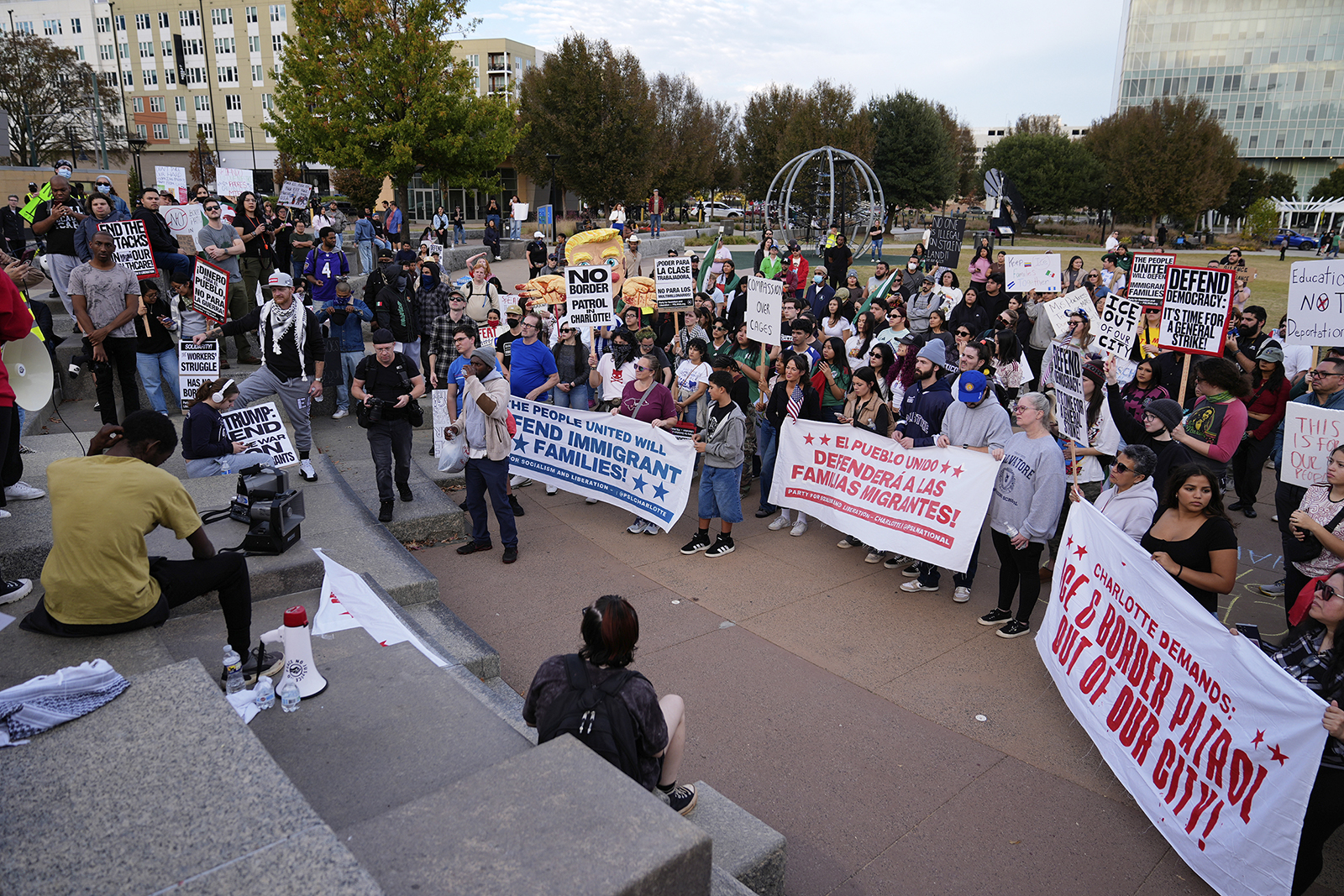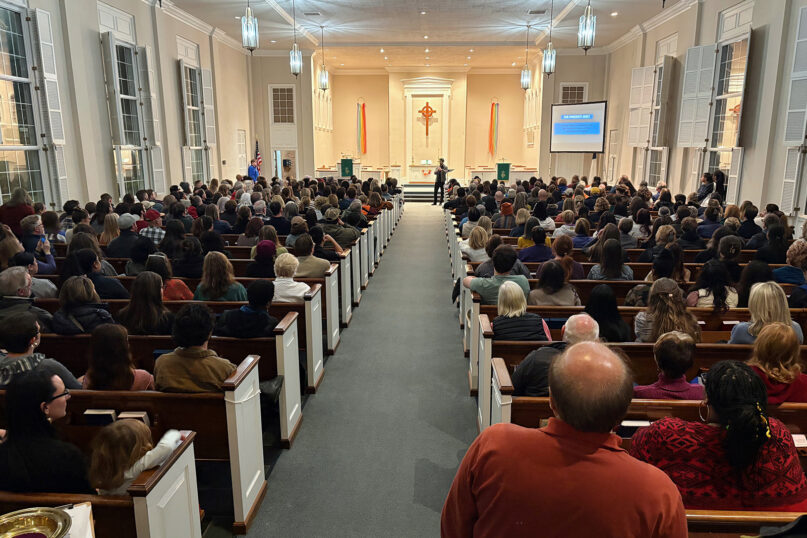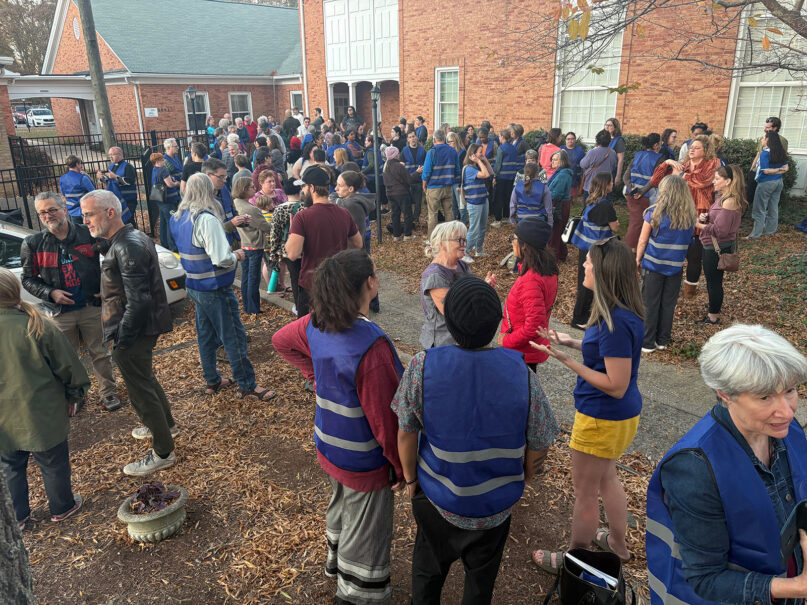
(RNS) — For nearly 2 1/2 years, Amity Presbyterian Church in Charlotte, North Carolina, has considered itself one congregation that mostly operates as two separate worship services: One, conducted in English, draws largely white worshippers, while the other, attended mostly by refugees from Africa, is conducted in Swahili.
But when the churchgoers found out over the weekend that U.S. Department of Homeland Security agents, launching a citywide immigration enforcement action known as “Operation Charlotte’s Web,” had visited the grounds of a Spanish-speaking church just two blocks away, Amity Presbyterian made a quick decision: On Sunday (Nov. 16), it would worship as one community.
“We decided, ‘We need to be together,’” the Rev. Megan Argabrite, lead pastor at the church, said.
In a second impromptu decision, the church announced it would host a training on how to respond to the influx of federal immigration agents into the neighborhood. Later that evening, nearly 300 people filled Amity Presbyterian’s sanctuary to listen to representatives from Siembra NC, a secular immigrant rights group.
Argabrite said hymns found their way into the training anyway. “They sang ‘This Little Light of Mine,’ and it was led by a child,” she said, including an improvised lyric: “All around Border Patrol, I’m gonna let it shine.’”

People attend a training about federal immigration actions at Amity Presbyterian Church in Charlotte, N.C. (Photo by the Rev. Megan Argabrite)
Taking cues from religious leaders in Los Angeles, Washington and Chicago who have made headlines for protesting President Donald Trump’s mass deportation policies and confronting Immigration and Customs Enforcement agents, clergy in Charlotte say they are rushing to do what they can to protect and support immigrants in their communities.
According to the Rev. Joel Simpson, pastor at First United Methodist Church Taylorsville, the rapid religious response to ICE is partly the result of serendipitous planning. Simpson said he and other local Methodists began reaching out “four or five months” ago to faith leaders in other cities, hoping to learn best practices. He also attended an immigration summit earlier this year convened by the UMC’s General Commission on Religion and Race and forged relationships with various immigrant rights groups in the region.
Faith leaders had expected the Charlotte area would see an uptick in ICE activity two months from now, in January, when additional funding for the agency passed by Congress takes effect. When Border Patrol officials arrived earlier, their first arrests coincided with the trainings organized by a coalition of religious and secular partners. “Just over the weekend, we probably trained almost 1,000 people to be ‘ICE Watch,’” said Simpson, who also helps lead Moral Mondays, a long-standing faith-led advocacy effort in the state begun by the Rev. William Barber II.
Churches have hosted several of the trainings so far, Simpson said, with attendance ballooning to as many as 500 at one event. Clergy are already in the streets observing DHS officials and have put into practice the techniques they were drilled on at the sessions, such as filming detentions and blowing whistles to alert locals of the presence of immigration officials.
The Rev. Laura Byrch, a UMC pastor, said in an email that she and another clergy member were scouting out a location for potential ICE presence when two vehicles “each with 3 agents in vests” pulled up to a barbershop across the street. “We immediately started recording on our phones and blowing our whistles,” Byrch wrote.

Attendees practice patrol duties during an immigration training session at Amity Presbyterian Church in Charlotte, N.C. (Photo by the Rev. Megan Argabrite)
When the agents spotted her and the other clergyperson, who were both wearing stoles, the officials remained in their cars and “very promptly turned around and left,” Byrch wrote.
Some churches are altering procedures to better protect their congregants. The Diocese of Charlotte told RNS on Thursday that Our Lady of Guadalupe Catholic Church, west of downtown Charlotte, has “dialed back” all activities other than Mass, where attendance saw a significant dip over the weekend.
Schools are another place where clergy are planning to show up as a deterrent to ICE, responding to reports that nearly 21,000 Charlotte-Mecklenburg students were absent from school on Monday, a trend many attribute to fears surrounding ICE’s presence.
On Wednesday, the Rev. Matt Conner, pastor at Newell Presbyterian in northeast Charlotte, said he was planning to join other clergy at a local school that day at student drop-off and pickup times. ICE agents, he said, had been spotted across the street from the school earlier in the week, and faith leaders planned to alert students, teachers and parents if other immigration officials were spotted.
“It’s visually meant to be a sign of solidarity in a season when I think so many of our neighbors feel very alone and isolated,” said Conner, who noted he was in Los Angeles when ICE greatly expanded its presence in that city this summer.
Conner said he also planned to join a Lutheran pastor and other clergy to offer “parking lot pastoral care” for teachers who “have watched kids they love stay out of school because they need to.”
“When Jesus says the most important commandment is to love God and love neighbor,” Conner said, “this is what love of neighbor looks like in this season.”
Local faith leaders have issued statements and convened prayer vigils. A group of clergy, including Simpson and the Rev. Rodney S. Sadler, a Baptist minister and Bible scholar, spoke at or attended a large protest over the weekend.
Argabrite said that while very real fear sometimes permeates the pews at Amity Presbyterian, she also believes the presence of DHS has “galvanized” the community. “Folks realize that we need each other,” she said. Initially, Argabrite was unsettled that DHS officials named the operation in her city “Charlotte’s Web,” but she has since come to appreciate it in an unexpected way.
“We have become so much more aware of the web of Charlotte — Charlotte’s web of love, Charlotte’s web of support,” she said. “I hope it grows.”
